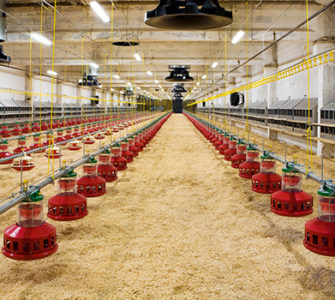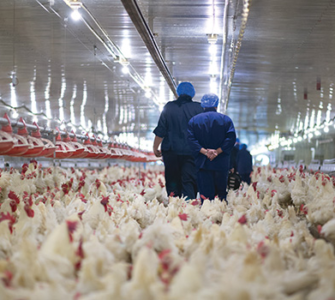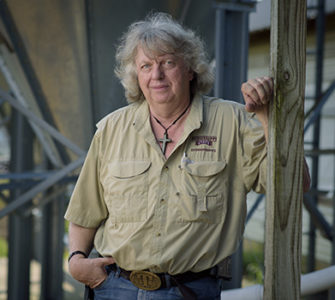Cooling chickens with sprinklers has multiple benefits
By Tom Tabler, PhD
Extension Professor
Mississippi State University Extension Service, Poultry Science Department
Mississippi State, Mississippi
Cooling broilers with sprinkler technology is a concept many folks in the poultry industry find difficult to accept. However, a sprinkler system cannot only dramatically reduce water use, it enables better humidity control. There’s also increasing evidence that performance among birds raised with a sprinkler system is comparable to birds raised with cool-cell systems.
Many people believe high temperatures kill chickens, but that’s not necessarily the case. Chickens can tolerate fairly high temperatures if the humidity is low. It’s the combination of temperature and high humidity that’s deadly.
In the early 1980s, before the advent of cool cells and when I was a broiler service tech in Arkansas, I saw many summer days when the house temperature was 90° F (32° C) or higher but humidity was below 50%. No birds died from the heat.
I also saw days when house temperatures were in the low-to-mid 80s (27° C to 29° C) but humidity was 80% or higher. Chickens died by the thousands from heat prostration. This was often after summer thunderstorms moved through around 3 p.m. The sun was back out by 4 p.m., and folks were picking up dead birds by 6 p.m. Even today, with cool cells and moderately low house temperatures in the 82° F to 85° F (27° C to 29° C) range, high humidity can be a death sentence for near-market-age birds.
Impact of humidity
The humidity level in a poultry house is critically important because unlike other animals and humans, chickens can’t sweat. They have to breathe out excess heat and moisture to cool themselves. If the air they breathe in has 50% humidity, there’s 50% air left to take up heat and moisture, which can then be expelled. When the air has 50% humidity, chickens can get rid of a lot of excess heat.
Conversely, if the air chickens breathe in is 90% humidity, there’s only 10% air left to take up heat and moisture. Chickens have to work really hard to cool themselves. If they can’t breathe heat and moisture out fast enough, their body temperature rises and they eventually “drown” from the excess moisture and heat load.
A humidity level of 90% isn’t unusual in a house with cool cells. In a house with a sprinkler system, the air breathed in has about 50% humidity, and the opportunity for heat removal is much greater.
Sprinkler concept
Few in our industry understand the sprinkler concept, but maybe I can help with that. With sprinklers, you’re cooling individual chickens. Much smaller amounts of water are needed because you aren’t cooling the entire house as you are with cool cells. Using a preset time interval, chickens are sprinkled every now and then with large drops of water.
With sprinkling, tunnel fans pull air across the birds, allowing the wind-chill effect to bluff chickens into thinking the chicken house is cooler than it really is. It’s the same principal as if you jump in the creek on a 100° F (37° C) summer day when there’s a breeze blowing. When you get out, the breeze evaporates the water off your skin and it feels pretty good. You don’t think it’s that hot until the water evaporates and it’s time to jump in the creek again.
Besides making it easier for birds to cool themselves by lowering humidity, water-sprinkled birds stand up and move around, often making a trip to feeders and drinkers. That movement releases heat trapped between the birds, which is then removed by the fans. With market-age birds, the hottest place in a broiler house on a hot summer day is between birds on the floor. Getting birds to stand and move is critical to getting excess heat out of the house.
House runs hotter
To achieve lower humidity with a sprinkler system, you have to run the house hotter than you would with conventional cool cells. This scares most folks. It used to scare me as well, but I’ve been involved with sprinklers of one form or another for over 20 years and have found the technology works when managed properly. In addition, bird performance is as good or better as it is with only a cool-cell system.
In summer, the temperature in a poultry house with cool cells usually runs around 82° F to 84° F (27° C to 29° C). Panic sets in if the house temperature goes above 85° F (29° C), but humidity may be near 90% or higher. Although a house with a sprinkler system must run hotter, humidity is lower because as temperatures rise, humidity decreases and chickens breathe easier.
When I’m using sprinklers in a broiler house, I want the air temperature around 87° F to 88° F (30° C to 31° C). That forces humidity low enough to allow the wind-chill effect to evaporate the sprinkled water off birds before the next sprinkle cycle comes along. Birds need to dry off between cycles. Don’t let them get wet and stay wet because you’ll end up with wet floors. In my opinion, a house temperature less than 87° F to 88° F (30° C to 31° C) is too cool if you are running sprinklers.
Sprinkler cycle
How often chickens get sprinkled depends on age and the temperature outside.
I usually don’t start sprinkling until birds are at least 4.5 weeks old. I want the house filled so that most of the sprinkled water goes on birds, not on the floor.
Whenever the sprinkler runs, it’s for 20 seconds and I never change that. I do change the interval between runs as chickens get bigger. When they are about 4.5 weeks old, I sprinkle once every 30 minutes. As they get bigger, I decrease that interval so that by 6 weeks of age, birds are sprinkled every 20 minutes; by 7 weeks of age, it’s every 10 minutes and by 9 weeks of age, maybe every 5 minutes depending on outside conditions.
It’s important to watch birds and sprinkle again at about the time they get dry from the previous run. As they get bigger and the outside temperature gets hotter, the time for them to dry off between runs becomes less and less. You have to watch what happens and adjust accordingly.
First-hand experience
We have two commercial houses at the university where we grow chickens for a Mississippi poultry integrator. Both houses were constructed with cool cells, but about 5 years ago we added a sprinkler system to each. Because of the size bird we grow and the heat and humidity in the region, I use only sprinklers until the house temperature gets to around 89° F to 90° F (32° C ). At that point, I also run the cool cells.
Instead of letting the cool cells come on at 82° F (27° C), as is common practice, I force the set point up and do not allow them to run until 88° F to 89° F (31° C to 31°C). Trying to maintain a house temperature near 90° F (32° C) instead of 82° F (27° C) saves a lot of water, which the sprinklers allow me to do and still get good performance. I couldn’t run the house temperature near 90° without the sprinklers — it would kill the chickens. So far, I haven’t killed any (knock on wood).
Table 1 shows results with our most recent flock using the combination of sprinklers and cool cells. Table 2 shows results when only cool cells were used compared to the sprinkler/cool-cell combination.


Retrofitting a house with a sprinkler system isn’t complicated or expensive. We used a commercial system that has its own controller and does not run through the chicken house controller. Besides the control box, there are rubber drop tubes for the sprinklers every 20 feet, spinner heads that attach to rubber tubes that sprinkle water every 20 feet and enough 0.75-inch PVC pipe to run two lines above the feed lines that are the length of the house.
It’s clear from my experience that sprinklers lower humidity in the house and lessen heat stress on birds. Furthermore, sprinklers can help maintain drier floors, which improves paw quality. They offer huge water-savings potential, which is increasingly important as the poultry industry endeavors to lessen its environmental footprint.
When managed properly, sprinkler technology does all of this without negatively affecting live performance. However, it requires a totally different perspective toward cooling chickens. To be successful, you must accept this new approach to bird cooling and allow the house to run several degrees hotter than you have been comfortable with in the past.
1. Liang Y, Watkins SE, Tabler GT, McCreery D. 2012. Sprinklers cool birds and conserve water. University of Arkansas Cooperative Extension Service. Fact Sheet FSA1073. Accessed April 22, 2019.
Editor’s note: The opinions and advice presented in this article belong to the author and, as such, are presented here as points of view, not specific recommendations by Poultry Health Today.
Posted on August 18, 2022

















